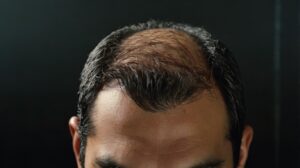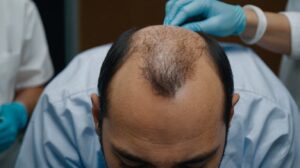Understanding Hair Loss: Causes, Diagnosis, and Advanced Treatment Options
By Faramarz Rafie M.D. / Vancoderm Academy (VDA) / Vancoderm Clinic (VDCmed)
Hair loss, also known as alopecia, affects millions of individuals of all genders and ages. Although often viewed as a cosmetic concern, it can also reflect underlying health issues including hormonal imbalances, nutritional deficiencies, or autoimmune diseases. At Vancoderm Academy, we offer a science-based and patient-centered approach to hair restoration using the latest diagnostic methods and advanced therapies such as exosome therapy, platelet-rich plasma (PRP), Microneedling, and biobanking.
Etiology: What Causes Hair Loss
Hair loss can result from a combination of internal and external factors. Common causes include:
Genetic and Hormonal Causes
Androgenetic alopecia is the most common form of hair loss and is driven by genetic sensitivity to dihydrotestosterone (DHT). Hormonal fluctuations related to pregnancy, menopause, thyroid dysfunction, or polycystic ovarian syndrome (PCOS) can also alter the normal hair cycle.
Autoimmune and Inflammatory Conditions
Autoimmune diseases such as alopecia areata, lichen planopilaris, and discoid lupus erythematosus cause the immune system to mistakenly attack hair follicles.
Nutritional Deficiencies and Metabolic Imbalances
Lack of essential nutrients including iron, zinc, vitamin D, biotin, and protein can weaken hair structure and growth.
Anorexia Nervosa and Hair Loss
Anorexia nervosa is a serious eating disorder marked by extreme food restriction, low body weight, and a distorted body image. It can significantly affect hair health by inducing telogen effluvium, where hair prematurely enters the shedding phase. Hormonal disruption, such as decreased estrogen and thyroid hormone levels, and nutrient depletion, especially protein and iron, can also cause widespread thinning. In some severe cases, lanugo (fine, soft hair on the body) may develop as the body attempts to regulate temperature. Treatment of hair loss in this condition requires psychological care, nutritional support, and medical monitoring.
Dermatological Conditions
Oily scalp and seborrheic dermatitis contribute to inflammation and follicle dysfunction. Scalp psoriasis and chronic folliculitis can also result in patchy or diffuse thinning.
Stress and Environmental Triggers
Telogen effluvium is a temporary form of diffuse hair shedding caused by physical or emotional stress, including surgery, illness, childbirth, or major weight loss. Hair loss can also result from trichotillomania, a hair-pulling disorder, or as a side effect of medications such as chemotherapy agents or retinoids.
Types of Hair Loss
 Androgenetic Alopecia (Pattern Hair Loss)
Androgenetic Alopecia (Pattern Hair Loss)
Male pattern hair loss (MPHL) typically begins with recession at the temples and thinning at the crown. It may progress to complete baldness and is classified using the Norwood Scale.
Female pattern hair loss (FPHL)presents as diffuse thinning over the crown or mid-scalp while usually preserving the frontal hairline. It is commonly graded using the Ludwig Scale. It tends to begin after menopause and progresses more slowly than male pattern hair loss.
Alopecia Areata
This condition is characterized by round patches of hair loss that may resolve spontaneously or progress to complete loss of scalp or body hair.
Telogen Effluvium
This is a reversible condition involving diffuse shedding that typically occurs two to three months after a triggering event such as illness or stress.
Anagen Effluvium
This form of hair loss occurs during the active growth phase and is most associated with chemotherapy.
Cicatricial (Scarring) Alopecia
These are inflammatory disorders that destroy hair follicles and replace them with scar tissue, resulting in permanent hair loss.
Traction Alopecia
This is caused by repetitive pulling on the hair from tight hairstyles such as braids or buns, leading to gradual hairline recession.
Diagnosis of Hair Loss
Proper diagnosis is essential for effective treatment. Diagnostic evaluation includes:
- Detailed medical history and scalp examination
- Hair pull test and hair shaft evaluation
- Trichoscopy to assess follicle structure and miniaturization
- Scalp biopsy for cases of scarring alopecia or unclear diagnosis
- Blood tests to measure ferritin, vitamin D, thyroid function, testosterone, DHEA-S, and autoantibodies
Medical Treatments
Topical Therapies
Minoxidil (2 to 5 percent) is the first-line topical agent that increases blood flow and follicle activity. Topical corticosteroids may be prescribed for inflammatory types. Other effective topicals include ketoconazole shampoo, peptide-based serums, and growth factor formulations.
Systemic Therapies
Finasteride and dutasteride are used in men to block the conversion of testosterone to DHT. Women may benefit from anti-androgens like spironolactone, especially when hormonal imbalance is present. Oral minoxidil is increasingly used off-label in low doses for diffuse hair loss. Systemic corticosteroids, immunosuppressants, and nutritional supplements may also be used depending on the diagnosis.
Advanced Procedures and Regenerative Therapies
Platelet-Rich Plasma (PRP)
PRP therapy involves injecting concentrated platelets from the patient’s own blood into the scalp to stimulate follicles and improve hair density.
Exosome Therapy
Derived from stem cells, exosomes contain growth factors and proteins that support follicular regeneration, reduce inflammation, and promote cell signaling.
Hair Transplantation and Implantation
Follicular Unit Extraction (FUE), Follicular Unit Transplantation (FUT), and Direct Hair Implantation (DHI) are surgical options for permanent hair restoration using the patient’s own hair grafts.
Microneedling and Dermal Pen Therapy
Microneedling creates microchannels in the scalp that stimulate collagen production and improve the absorption of topical agents like minoxidil, PRP, and exosomes.
Low-Level Laser Therapy (LLLT)
Red light and infrared therapies delivered through laser combs, helmets, or clinical devices increase ATP production, enhance follicular energy, and reduce inflammation.
Scalp Micropigmentation (SMP)
This is a non-surgical cosmetic procedure that creates the appearance of thicker hair using medical tattooing techniques.
Biobanking and Future Therapies
Hair follicle biobanking involves cryopreserving stem cell-rich follicles from the patient for potential future use in regenerative therapies or cloning-based restoration.
Benefits include
- Long-term storage of healthy follicle cells
- Personalized therapy in the event of progressive loss
- Compatibility with future technologies such as hair cloning and 3D follicle regeneration
Combination Treatment Plans
Multimodal treatment is often the most effective. Vancoderm Academy offers personalized programs combining options such as:
- PRP and Microneedling /Dermal Pen
- Oral and topical therapy
- Hair transplant with post-op Low-Level-Laser-Therapy
- Exosome therapy with hormonal support
- Biobanking with advanced regenerative care
Why Choose Vancoderm Academy
Vancoderm Academy is a leader in trichology and regenerative aesthetics. We offer:
- Evidence-based clinical consultations
- Certified training in Trichology, hair science, exosome therapy, and treatment procedures.
- State-of-the-art devices and protocols
- Hands-on learning and practitioner mentorship
Final Thoughts
Hair loss is a treatable condition when approached holistically. Whether the cause is hormonal, autoimmune, stress-related, or nutritional, modern medicine offers multiple solutions to restore hair health and confidence. With advances like Microneedling, Dermal Pen, exosomes, and biobanking, the future of hair restoration is not only promising—it’s here.
Start Your Journey
If you are experiencing hair loss or are a practitioner seeking expert training, contact Vancoderm Academy today to schedule a consultation or enroll in our professional certification programs.
Interested in a professional hair loss consultation or training in medical trichology?
Contact Vancoderm Academy today to learn more about our advanced hair restoration programs and services.

